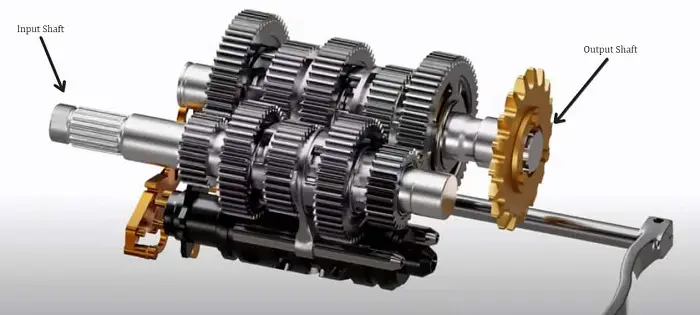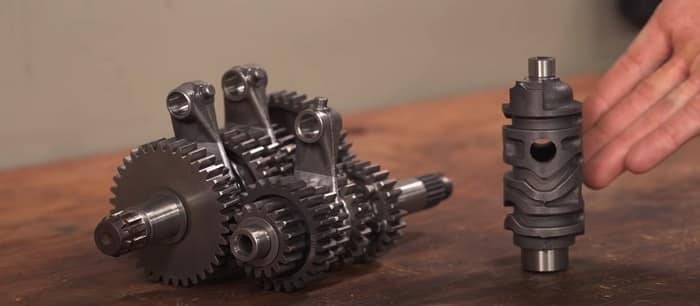For most people, their motorcycle transmission is one of the most mysterious parts of their bike.
How does it work, and why do we shift down into first, but then up for the rest of the gears?
The transmission is one of the most intimidating parts of a motorcycle. There are many sprockets and one set of cogs for each gearbox ratio, but the transmission operation is pretty straightforward, and so is its purpose.
The whole reason behind the transmission it provides a range of gear ratios to suit different torque needs and engine speeds.
Is Shifting a Motorcycle Like Shifting a Car?
A motorcycle transmission is a constant match sequential gearbox. That means the gears are always meshed together, and you shift in order as opposed to in a car transmission where you can stick it in any gear you want.
Here are all the components laid out. You have your input shaft, which has the clutch mounted to the right end and is turned by the crankshaft.
Then, the output shaft with the sprocket on its left-hand turns the chain and the rear wheel.

Some of the gears are splined to the shaft, but they can move side to side, while others are free to rotate but stay in place.
There are pegs, and they are called dogs, and they nest into corresponding recesses on adjacent sprockets.
When neighboring gears are slid together, they lock and rotate as one.
That’s why we call it shifting gears because you are literally shifting the gears back and forth on the shafts, and the way those gears get moved around is by shift forks.
There are three shift forks, and they rest in grooves in the spline gears. Some pins run in dedicated channels in the shift drum at the other end of the forks, which is this weird-looking thing right here.

When you tow the shifter, it rotates the shift drum, which moves the shift forks and shifts Gears.
But why is first gear down second gear up? Why is neutral between the two of them, and why is the shifter on the bike’s left side anyway?
Let’s start with the political reasons. I think it’s pretty interesting that regulations state that the shifter has to be on the bike’s left side.
When you click it up, it will move you to a higher gear, then clicking it down will move you to a lower gear.
Those regulations were passed in the 70s, and they pretty much served to standardize motorcycle shifting around the world.
America was a huge market, and manufacturers everywhere conformed.
As for neutral being where it is, that is primarily a function of safety and convenience.
Neutral could be below first gear, it could be above 6th, it could even be between third and fourth, but it’s located between first and second because that makes the most sense.
You only shift into neutral when you’re coming to a stop, and you’re only coming to a stop when you’re in the lower gears.
Neutral could be located below first gear, but then you might accidentally end up in neutral when you’re trying to shift down into first.
As it stands, you just keep mashing down on that lever, and you’ll be in first gear, ready to let the clutch out and pull away from a stop.
Are Motorcycles Manual or Automatic?
A motorcycle can come with both manual and automatic transmission. But there are all sorts of automatic or non-conventional transmissions in motorcycling, and there have been for a really long time.
We could back up to the 70s, where at one point, the sales of motorcycles were doing great, but they started to slack off just a little bit.
Someone over at Honda had the idea that, well, perhaps the shifting is the problem.
They developed the Hondamatic, which came out as the CB400Aa, the CB450A, and the CB750A.
All of those motorcycles had two-speed transmissions. You had to shift the gear yourself, but obviously, it was only one gear change, so it wasn’t difficult as there was no clutch, so it was pretty easy to get one of those things rolling.
Unfortunately for Honda, they were a sales flop. I think they were a flop because by that point, most of the people who already wanted to learn how to ride a motorcycle just mastered a conventional transmission and moved on.
We can fast forward in time where there have been other examples. Riddley made the auto glide, and nowadays, Honda has DCT’s on many other motorcycles.
These DCT’s are actually kind of interesting, and they’re the closest thing to an automatic motorcycle transmission I can think of.
Unlike the previous Hondamatic, you simply hit the D button, and that does all of the gear shifting for you with no clutch action.
Then, of course, we also have electric motorcycles. At this point, I can’t really think of a commonly available electric motorcycle that has a transmission.
Those are just twists and go, and then, of course, you’d also want to bring up something like a scooter.
We’ve had scooters for years and years, and most of those are twist and go as well.
All of this says to me that this isn’t the thing preventing new riders from entering motorcycling.
A million other reasons are stacking up to keep people from trying out bikes, but I don’t think that this one is it.
Do all motorcycles have the same shift pattern?
All motorcycles have the same sequential transmission but not the same shift pattern. A sequential gearbox means you have to go through each gear in sequence. The shift pattern can change from Japanese bikes with a N 1 2 3 4 5 shift pattern to modern motorcycles with one down and five gears up.
So there you have it, the basics behind the motorcycle transmission, how it works and why.
And if you’ve got sticky shifting on your bike, you might need to change the oil.
As we showed you, there are many rotating interlocking and sliding parts in the transmission, and if your oil is dirty, it’s not going to lubricate that stuff well.
Questions answered in this article


